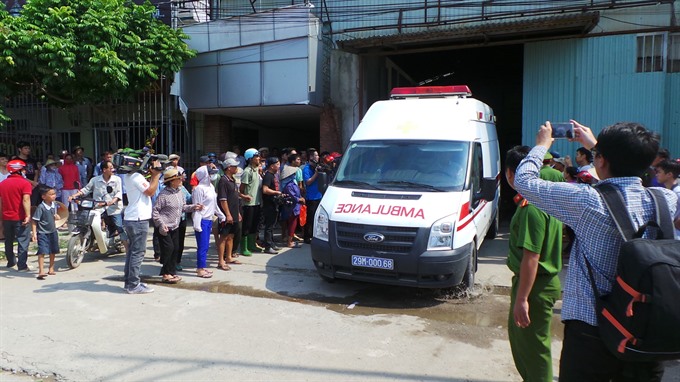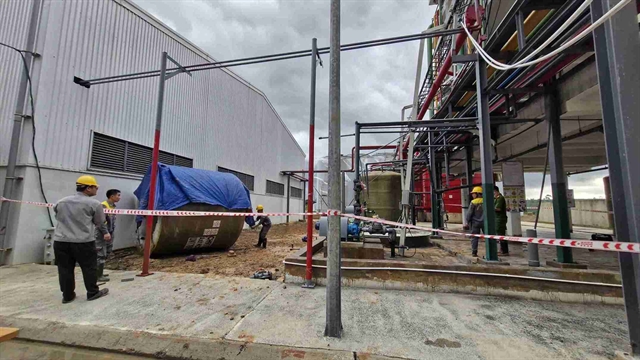 Society
Society

The July 29 bakery fire that claimed the lives of eight workers, mostly teens, once again highlights the lax fire safety practices in factories and warehouses in the capital city.
 |
| The confectionary factory in Hoài Đức District where a fire occurred last weekend and claimed 8 lives. — VNA Photo |
HÀ NỘI — The July 29 bakery fire that claimed the lives of eight workers, mostly teens, once again highlights the lax fire safety practices in factories and warehouses in the capital city.
The 170sq.m confection factory in Ha Noi’s Hoài Đức District, owned by Nguyễn Văn Được, 25, caught fire that quickly consumed the workshop filled with combustible materials. The dead victims were mostly teenagers, members of the same family and also related to the factory’s owner. They all hailed from a poor village, Long Xuyên, in the capital’s Phúc Thọ rural district.
The Prime Minister himself interceded in the latest tragedy, ordering Hà Nội authorities to deliver proper support for the victims and their families and to report to him the findings of their investigation.
Initial reports by the Hà Nội People’s Committee and police indicate that during repairs, sparks and hot slag from welding set the styrofoam ceiling on fire, which caused the attic to collapse. Burning debris then blocked the sole exit – the front entrance – trapping the victims inside.
The tragedy follows a particularly devastating fire at the end of last year at a karaoke bar on Hà Nội’s Trần Thái Tông Street, which was also ignited by welding slags and ended with 13 deaths and scores of injured. Despite the widespread coverage of the fire and the lack of safety precautions, the latest accident proves that there has been little improvement.
Many welders are not professionals with proper licences, qualifications, or fire safety knowledge. Nguyễn Anh Thơm of the Hà Nội lawyers association told Người Lao Động (The Labourer) that in this case, the welder will be held criminally responsible for flaunting fire safety regulations.
Sub-standard factories
However, as was pointed out, the bakery also had no fire exits, reflecting the rampant negligence by owners and managers of manufacturing factories and warehouses.
Ha Noi’s urban districts like Cầu Giấy, or the outlying district of southern Từ Liêm or Hoài Đức, are filled with small-scale factories and warehouses, with floor areas ranging anywhere between hundreds of square metres to thousands. Most are built with a steel frame and a corrugated iron roof on empty lots tucked in between residential neighbourhoods.
La Phù village in Hoài Đức District is an area teeming with confectionary workshops - both bakeries and cane makers - many of them carbon copies of the one that burned down. Inside flammable objects are often stacked to the roof – Styrofoam, plastic packaging material, cardboard boxes, paper materials, among others. However, the majority of these factories are not outfitted with a fire alarm system and only have a single entrance/exit.
Safety compliance review Following a series of deadly fire accidents in residential homes and home-based manufacturing businesses across the country, the Department of Fire Prevention and Fighting Police and Rescue asked agencies under their administration on July 30 to conduct a complete review of fire safety compliance in home-based and small-scale enterprises. Fire-fighting police has also been tasked with counselling People’s Committees of all levels on fire safety protocols for residential buildings and home-based manufacturing facilities. Local governments are urged to take stock of all small-scale businesses and home-based manufacturing in their jurisdictions to enforce fire safety compliance with regard to equipment, the arrangement of goods, safe management of electric and heat sources, and especially evacuation plans in case of fire. — VNS |
Tạ Văn Thắng, Chairman of La Phù Commune People’s Committee, said that one in two to three months, fire authorities conduct inspections and fine violators.
The owner of the burnt bakery was arrested on July 30 and Nguyễn Anh, Vice Chairman of the Hoài Đức District People’s Committee, said the district had immediately carried out fire safety inspections of 1,000 manufacturers. They found that all had proper licences and fire safety equipment, and had organised fire drills. “Only Được’s factory had not been checked nor did it have proper licences prior to the accident,” Anh said.
Hà Nội fire agency said that even with regular inspections, the efficacy remains “limited,” explaining that when inspectors come, factory owners might follow fire safety standards, but once the inspectors are gone, all precautions are thrown to the wind. The most common types of violations, not including inherent fire hazards in the construction of the factory itself, are inappropriate arrangement of goods in the warehouses, blocking the entrance or the access of fire trucks, etc., they said.
Most fires occur in temporary warehouses and factories rented on a short lease of six months or a year, and the "buildings" are in fact steel frames and a tin roof put together. Assistant Prof Dr Ngô Văn Xiêm, former director of the Fire Fighting University, said that factory owners still do not take fire safety seriously.
Xiêm also admitted that the lamentable situation stemmed from lax enforcement by authorities in making sure businesses and organisations follow strict fire safety protocols.
According to Hà Nội Fire Prevention and Fighting Police, in July alone, 70 fires broke out in the capital city, claiming 14 lives and causing economic losses of VNĐ100 billion (US$4.4 million). — VNS




